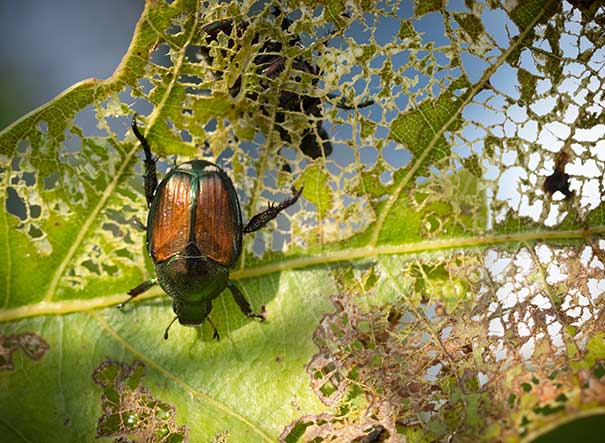
Over the past couple of weeks, we’ve had many customers visiting our garden center reporting sightings of Japanese Beetles damaging their plants. Initially, I thought it was a bit early for these pests, but with the mild winter we experienced, it makes sense that they’ve emerged earlier than usual. This goes to show that you can’t always rely on the calendar for gardening tasks – you need to stay flexible and follow what Mother Nature dictates.
This year, Japanese Beetles have truly become a “June bug” — although the term “June bug” isn’t scientifically defined, it’s commonly used regionally to refer to various beetle species. The Japanese Beetle (Cotinis nitida), easily identifiable by its shiny green body and size (about an inch long), is one of the most common offenders in our gardens. While not aggressive and harmless to humans, these beetles love to feast on plants such as roses and tomatoes, and can do significant damage if left unchecked.
How to Manage Japanese Beetles in Your Garden
If you’ve noticed Japanese Beetles in your garden, you’re likely also seeing their larvae—white grub worms—just below the soil’s surface. In fact, one of our customers recently discovered these grubs in her raised garden bed soil.
To protect your plants from Japanese Beetle damage, there are several strategies you can use:
-
Japanese Beetle Traps: These traps are effective for attracting beetles away from your plants. Place the trap in a remote area of your yard to lure beetles away from your roses, tomatoes, and other vulnerable plants.
-
Chemical Products: You can use sprays or dusts to control beetle populations. I highly recommend Captain Jack’s Deadbug Brew by Bonide, which is an organic option made with Spinosad. It’s safe for beneficial insects when used correctly and at the right time of day. Sevin, another effective option, comes in both liquid and powder forms and works wonders on beetle control.
Long-Term Control: Understanding the Life Cycle of Japanese Beetles
For long-term control of Japanese Beetles, it’s important to understand their life cycle. Here’s how it works:
-
The Cycle Begins: After feeding on your plants, the female beetle lays her eggs in warm, sunny areas of healthy grass (not in the shade). Each female can lay up to 200 eggs, which hatch within just four days into grub worms.
-
Grubs in Your Lawn: These grub worms feed on your lawn’s roots and remain in the soil until the fall when they burrow deep below the frost line to survive the winter. To prevent them from causing damage, you need to treat them before they burrow.
Best Products for Long-Term Control
For effective long-term control, it’s important to use a grub control product during the summer or early fall before the grubs burrow down. Here are two top products to consider:
- Bayer Advanced Grub Killer Plus: A chemical product that kills grubs on contact.
- Milky Spore: A biological, non-chemical solution that targets the grubs over time.
The key to success is timing. Apply these products in late summer or fall to kill the grubs before they burrow. Then, reapply in early spring, just as the grubs start emerging with the warmer soil.
Need Help with Your Garden? Visit Us Today!
If you’re dealing with Japanese Beetles or need advice on garden care, don’t hesitate to visit us at Meadows Farms. Our experts are ready to help you choose the best solutions for your garden’s health. Protect your plants and ensure your garden thrives all season long!

